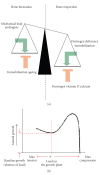Skeletal dysplasias associated with mild myopathy-a clinical and molecular review
- PMID: 20508815
- PMCID: PMC2875749
- DOI: 10.1155/2010/686457
Skeletal dysplasias associated with mild myopathy-a clinical and molecular review
Abstract
Musculoskeletal system is a complex assembly of tissues which acts as scaffold for the body and enables locomotion. It is often overlooked that different components of this system may biomechanically interact and affect each other. Skeletal dysplasias are diseases predominantly affecting the development of the osseous skeleton. However, in some cases skeletal dysplasia patients are referred to neuromuscular clinics prior to the correct skeletal diagnosis. The muscular complications seen in these cases are usually mild and may stem directly from the muscle defect and/or from the altered interactions between the individual components of the musculoskeletal system. A correct early diagnosis may enable better management of the patients and a better quality of life. This paper attempts to summarise the different components of the musculoskeletal system which are affected in skeletal dysplasias and lists several interesting examples of such diseases in order to enable better understanding of the complexity of human musculoskeletal system.
Figures





References
-
- Francomano CA, McIntosh I, Wilkin DJ. Bone dysplasias in man: molecular insights. Current Opinion in Genetics and Development. 1996;6(3):301–308. - PubMed
-
- Mogayzel PJ, Marcus CL. Skeletal dysplasias and their effect on the respiratory system. Paediatric Respiratory Reviews. 2001;2(4):365–371. - PubMed
-
- Harada S-I, Rodan GA. Control of osteoblast function and regulation of bone mass. Nature. 2003;423(6937):349–355. - PubMed
-
- Frost HM. Biomechanical control of knee alignment: some insights from a new paradigm. Clinical Orthopaedics and Related Research. 1997;(335):335–342. - PubMed
-
- Royce PM, Heinmann B. Connective Tissue and Its Heritable Disorders. 2nd edition. Zurich, Switzerland: John Wiley & Sons; 2002.
Grants and funding
LinkOut - more resources
Full Text Sources

